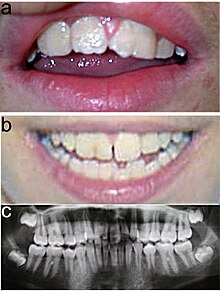KBG syndrome
| Classification according to ICD-10 | |
|---|---|
| Q87.8 | Other specified congenital malformation syndromes, not elsewhere classified |
| ICD-10 online (WHO version 2019) | |
The KBG syndrome , also Hermann-Pallister syndrome called, is a very rare genetic disease .
Description and symptoms


Typical of the KBG syndrome are facial dysmorphia ( facial dysmorphism ) and large upper central incisors. There are also anomalies of the skeleton , especially costovertebral, i.e. in the costal vertebrae, and delayed physical development. The latter leads to short stature . The majority of patients also have EEG abnormalities (with or without seizures) and an abnormal hairline . Cutaneous syndactyly , short neck with pterygium , cryptorchidism ("belly testicles"), hearing loss , strabismus , palate defects and congenital heart defects are significantly less common .
frequency
KBG syndrome is extremely rare. By 2006, about 45 patients in 26 families had been described worldwide. There are obviously more male patients with KBG syndrome. The gender ratio is around 2: 1. In female patients, the symptoms are not as pronounced as in males.
genetics
The KBG syndrome is caused by a heterozygous mutation in ANKRD11 - gene ( ankyrin repeat domain-containing protein 11 ), located on chromosome 16 , locus caused is q24.3. The gene product consists of 2663 amino acids, has a molar mass of 298 k Da and includes five ankyrin units.
The inheritance of the KBG syndrome is autosomal - dominant . In some cases, however, the mutations also appear to be spontaneous.
diagnosis
The diagnosis is mainly made on the basis of the symptoms, as a genetic test for the KBG syndrome is not yet available. There are four main features of the KBG syndrome: facial dysmorphism, macrodentia of the upper central incisors, skeletal anomalies (especially costovertebral) and delayed development. At the age of seven to eight years, macrodentia can make the diagnosis more reliable with the formation of the front incisors.
therapy
The treatment of KBG syndrome is purely symptomatic. Any malformations can in part be corrected surgically. Caring for the patient includes regular EEG measurements, a full orthodontic and skeletal examination, hearing tests, and ophthalmological checks. KBG syndrome is not a life-threatening disease. The prognosis is therefore - even if hardly any statistical data is available - to be classified as favorable.
Initial description
The KBG syndrome was first described in 1975 by Jürgen Herrmann , Philip David Pallister and John Marius Opitz . Opitz also gave the name KBG , which results from the first letter of the family name of his three affected patients.
further reading
- H. Kumar, N. Prabhu, A. Cameron: KBG syndrome: review of the literature and findings of 5 affected patients. In: Oral surgery, oral medicine, oral pathology, oral radiology, and endodontics. Volume 108, Number 3, September 2009, pp. E72-e79, ISSN 1528-395X . doi: 10.1016 / j.tripleo.2009.04.035 . PMID 19716495 . (Review).
- KL Skjei, MM Martin, AM Slavotinek: KBG syndrome: report of twins, neurological characteristics, and delineation of diagnostic criteria. In: American journal of medical genetics. Part A. Volume 143, Number 3, February 2007, pp. 292-300, ISSN 1552-4825 . doi: 10.1002 / ajmg.a.31597 . PMID 17230487 . (Review).
- F. Brancati, MG D'Avanzo et al. a .: KBG syndrome in a cohort of Italian patients. In: American journal of medical genetics. Part A. Volume 131, Number 2, December 2004, pp. 144-149, ISSN 1552-4825 . doi: 10.1002 / ajmg.a.30292 . PMID 15523620 .
- SF Smithson, EM Thompson, et al. a .: The KBG syndrome. In: Clinical dysmorphology. Volume 9, Number 2, April 2000, pp. 87-91, ISSN 0962-8827 . PMID 10826617 . (Review).
- I. Morghen, E. Ferri: The KBG syndrome: Case report. In: Cases journal. Volume 1, Number 1, 2008, p. 186, ISSN 1757-1626 . doi: 10.1186 / 1757-1626-1-186 . PMID 18822138 . PMC 2565666 (free full text).
Individual evidence
- ^ R. Witkowski, O. Prokop et al. Lexicon of Syndromes and Malformations. Springer, 2003, ISBN 3-540-44305-3 , p. 530. Restricted preview in the Google book search
- ↑ a b c d KBG syndrome. In: Orphanet (Rare Disease Database).
- ^ A b F. Brancati, A. Sarkozy, B. Dallapiccola: KBG syndrome. In: Orphanet Journal of Rare Diseases. Volume 1, 2006, p. 50, ISSN 1750-1172 . doi: 10.1186 / 1750-1172-1-50 . PMID 17163996 . PMC 1764006 (free full text). (Review article in Open Access ).
- ↑ a b KBG syndrome. In: Online Mendelian Inheritance in Man . (English)
- ↑ KBG syndrome. In: Online Mendelian Inheritance in Man . (English)
- ↑ M. Tekin, A. Kavaz et al. a .: The KBG syndrome: confirmation of autosomal dominant inheritance and further delineation of the phenotype. In: American journal of medical genetics. Part A. Volume 130A, Number 3, October 2004, pp. 284-287, ISSN 1552-4825 . doi: 10.1002 / ajmg.a.30291 . PMID 15378538 . (Review).
- ↑ J. Herrmann, PD Pallister u. a .: The KBG syndrome-a syndrome of short stature, characteristic facies, mental retardation, macrodontia and skeletal anomalies. In: Birth defects original article series. Volume 11, Number 5, 1975, pp. 7-18, ISSN 0547-6844 . PMID 1218237 .
